Chris Glein Game Design and Life
Mice Heist
In Mice Heist you are mice from a colony seeking to steal food from a human household. The player who returns with the best food will be the hero of the colony. But the food is protected by obstacles and traps, so you may have to reluctantly work together to overcome them and get the largest portion.
COMPONENTS
Modifier chips
| Blue | Green | Yellow | Orange | Red | Purple |
|---|---|---|---|---|---|
 |  |  |  |  |  |
 |  |  | 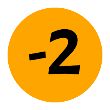 | 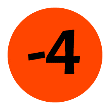 | 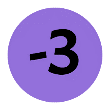 |
| x1 | x2 | x4 | x2 | x1 | x1 |
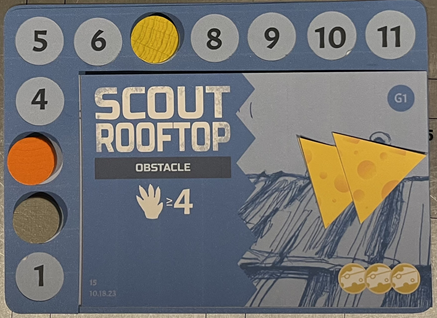 | 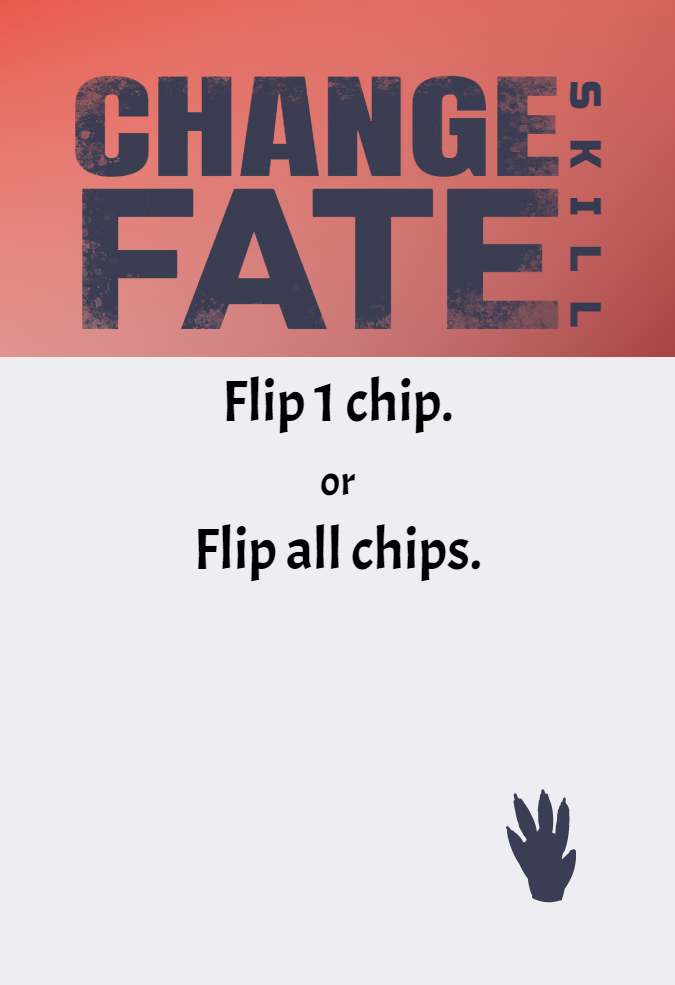 | ||
| 4 contribution tracks | 37 upgrade skill cards | ||
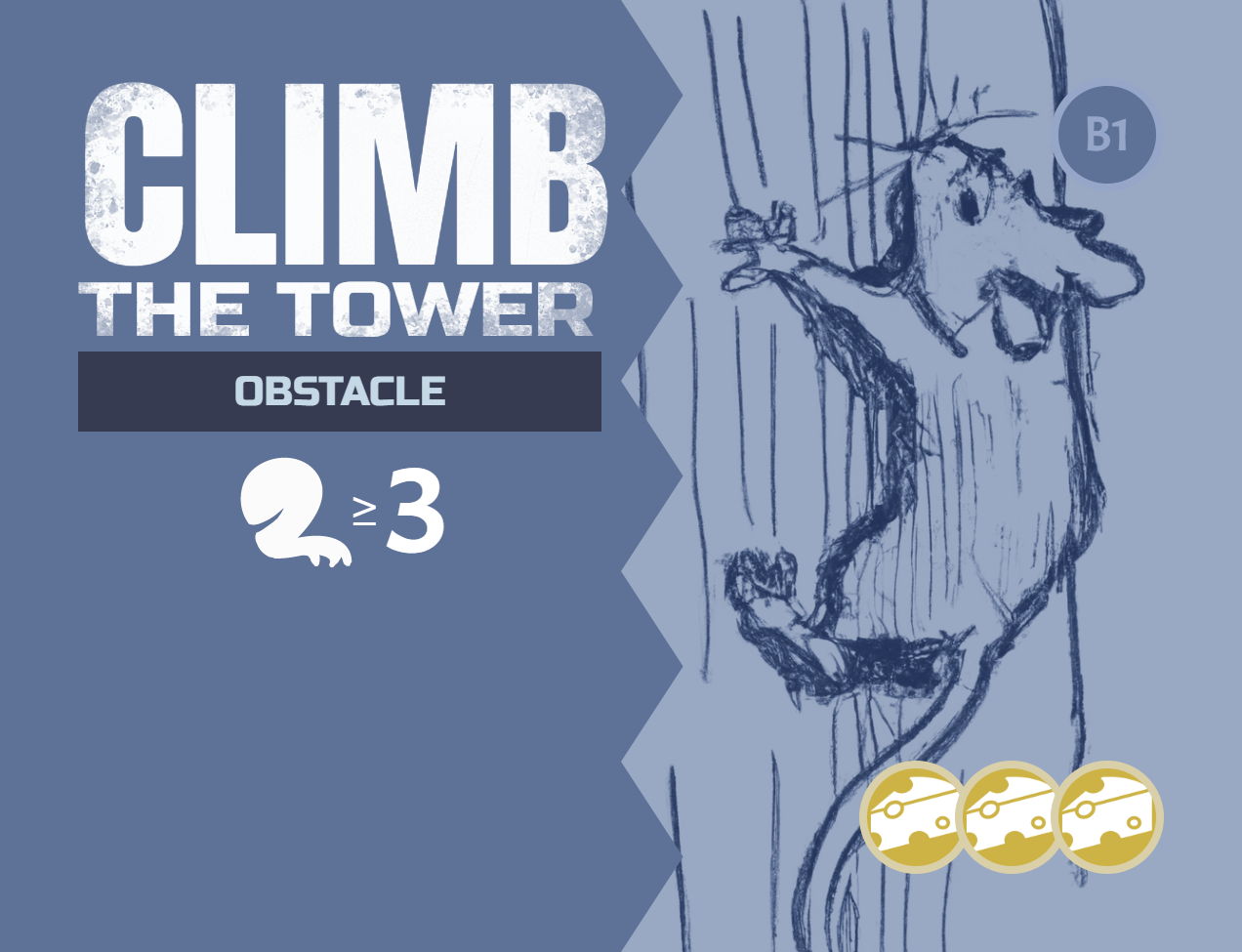 | 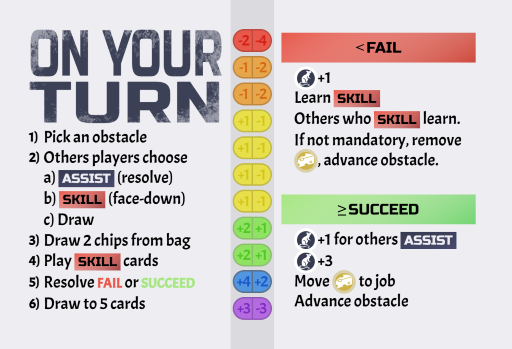 | ||
| 20 obstacle cards (5 per job) | 4 rules reminder cards | ||
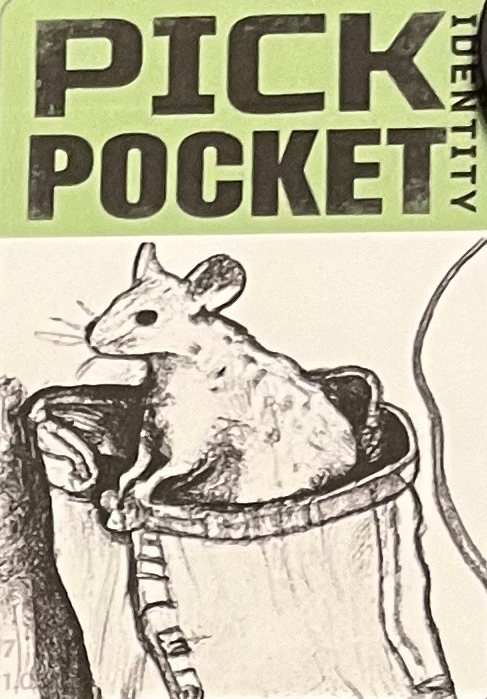 | 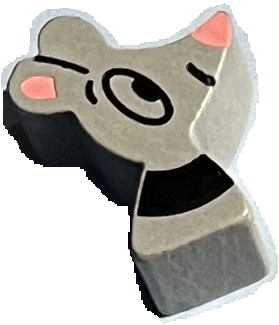 | </td>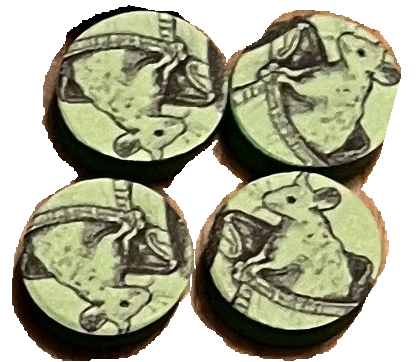 |
| 18 starting skill cards (3 of each player color) | Active job marker | 24 contribution markers (8 of each player color) |
 | 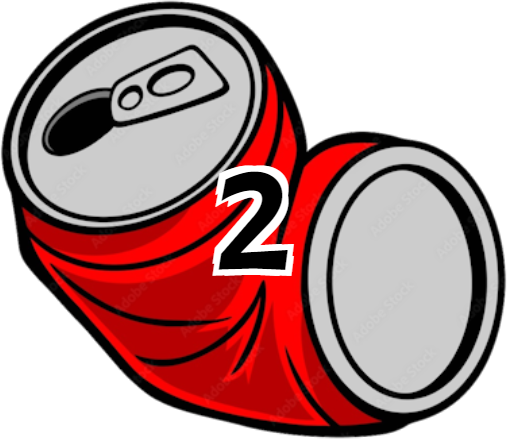 |  |
| 12 food tokens (4 each in values 20, 10, and 5) | 20 trash tokens | 1 opaque bag |
SETUP
Player Components
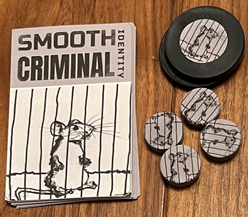 Update image to remove player chips
Update image to remove player chips
- Randomly assign each player one of available the player colors.
- Each player takes the components that match their player color and image.
- 3 starting skill cards
- 8 contribution markers
- Return the remaining player components to the game box.
Jobs
 Need updated picture for beginning of game, not end. And should include food.
Need updated picture for beginning of game, not end. And should include food.
- Place the 4 contribution tracks in the center of the table.
- Separate the obstacle cards by job set letter (e.g. “A”) displayed in the top right corner (e.g. set “A” has cards A1-A5).
- Sort each in numeric order so that the lowest number is on top (e.g. for job A obstacle A1 will be on top and A5 will be on the bottom).
- Place each sorted stack on top of a contribution track.
- For each job randomly select a 20 point, 10 point, and 5 point food item and place it next to the track.
Alternate setup option: Separate obstacle cards by difficulty and shuffle each difficulty tier into a pile. For each job randomly deal out deal out (from bottom to top):
- 1 difficulty 🐀🐀🐀🐀
- 1 difficulty 🐀🐀🐀
- 3 difficulty 🐀🐀
- 1 difficulty 🐀 </mark>
Skill market
- Shuffle the upgrade skill cards to form a face-down deck.
- Deal out 4 cards from the deck and place them next to the deck as a face-up market.
The rest
- Put the remaining trash in a central supply.
- Place all modifier chips in the bag.
- Randomly determine a starting player (you can use the player contribution markers for this). That player takes the active job marker and the bag.
GOAL
You are all attempting to pull off jobs to score food for your colony. Each job has a sequence of obstacles, which will test each player’s skill and luck. When the game ends players are each paid out in food according to how much they contributed. The player with the highest value food stash wins.
Contribution
Each job has a contribution track. When you contribute to the success of that job by overcoming obstacles you will add your player-colored marker to that track. The player with the most markers on the track will receive the highest value food. When adding to the track, add to the next available spot on the track, indicating who contributed last (which will break ties in their favor).
Obstacles

Each job has a stack of obstacles. Each of these will have the following elements:
- A target rating number
- Zero or more associated skill icons (e.g. 🤚🦵👄)
There are a couple of extra pieces of information only used for setup (they have no effect during gameplay):
- Difficulty (Number of 🐀 icons)
- Associated job and order in that job (e.g. “B1”)
Skills

You begin the game with 3 skills that can be used to help you overcome obstacles. You can gain more skills as the game progresses. Each skill is either in a ready state (face-up) or exhausted state (face-down).
To use a skill card, it must be ready. Execute the text on the card. Then flip it face-down.
To exhaust a skill card, it must be ready. Flip it face-down but ignore the text on the card.
To ready a skill, flip it face-up.
To learn a skill, choose an upgrade skill from the market. Add it face-up in front of you alongside your other skills. Deal out a new skill card from the deck face-up to the market.
YOUR TURN
Players each take a turn in clockwise order. Any reference to “you” is to the active player (who is currently taking their turn).
On your turn you will test against an obstacle with the following steps:
- Select Obstacle
- Others May Assist
- Draw Chips
- Use Skills
- Calculate Result
- Resolve (Success or Failure)
- Buy a Skill
- Cleanup
1. SELECT OBSTACLE
Choose an obstacle and place the active job marker on it to let everyone know where you will be testing.
2. OTHERS MAY ASSIST
Everyone else has an opportunity to bet on the outcome of your upcoming test. They may choose to exhaust one of their skill cards in order to gain a reward if the test is successful. Players choose to do this simultaneously, and must do so before the active player proceeds. Any player who pays this exhaust cost is considered to be as assisting player.
3. DRAW CHIPS
You now draw 2 chips from the bag without looking, at place them on the table.
The chips have mismatched sides. Do not look and choose the sides of the chips as you draw them. Leave them randomly assigned as they come out of the bag.
At times you may need to draw a chip when there are no chips remaining in the bag. When this happens, return all chips from the play area except the ones already drawn for this test to the bag. Then proceed drawing.
4. USE SKILLS
At this time you may use any number of ready skills one at a time to modify the chip results. Skill effects could involve flipping chips (to change which modifier value is showing), drawing additional chips, adding numeric modifiers, or any number of effects.



Note that some skills will indicate that they only have an effect when activated for obstacles that have a matching skill icon. TODO: Provide an example
5. CALCULATE RESULT
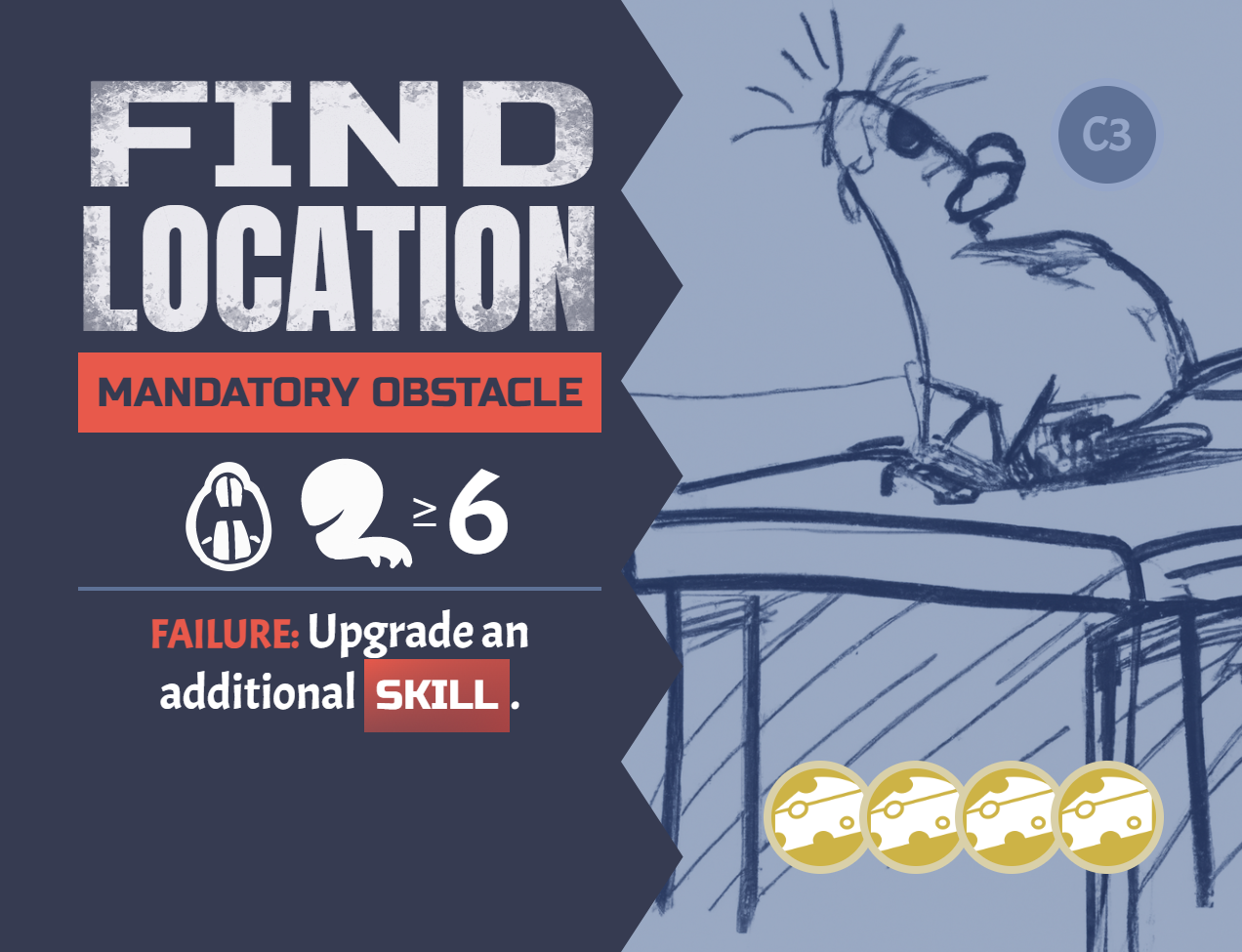
Add the following together:
- The modifiers on all chips drawn for this test
- The modifiers granted by any skills used for this test.
This value is your test rating.
6. RESOLVE (SUCCESS OR FAILURE)
If the test rating is less than the obstacle’s target rating you failed. Otherwise you succeeded.
FAILURE
- Ready all of your skill cards
- Take 1 trash from the supply.
SUCCESS
- Add one of your contribution markers to the job’s track.
- All assisting players take 1 trash from the supply.
- Return the obstacle to the game box.
7. BUY A SKILL
You may optionally return 1 trash to the supply in order to learn a skill from the market.
8. CLEANUP
If the there are no more obstacles remaining for the job then the game is over. Continue to “End Game & Scoring” below.
Otherwise:
- Move all other chips drawn for this test to the center play area (alongside with any chips drawn from previous tests).
- Pass the bag to the next player in clockwise order.
END GAME & SCORING
The end game is triggered when one of the jobs has been completed (there are no more obstacles in its stack).
Distribute food
For each job, players claim food tokens according to their number of contribution markers on the track. The player with the most markers gets 1st choice of food token, the 2nd place will choose next, and so on. Ties are broken by whoever among the tied players has a token furthest ahead on the track.
If all food tokens have been claimed for that job, any player with at least one contribution marker will instead take 1 trash.
Most points wins
Each player calculates their total score from their tokens:
- Food
- Trash (2 points each)
The player with the largest total is the winner. If there is a tie the player with the most trash is the winner. If there’s still a tie the players share the victory.